Push-ups seem like such a simple exercise, but when you’re starting out, they can feel impossible!
We all know push-ups are a great bodyweight exercise for beginners that can help strengthen your chest, shoulders, triceps, and core.
Push-ups seem like such a simple exercise, but when you’re starting out, they can feel impossible.
You struggle to get even one good rep, your form falls apart, and your wrists start to ache.
Don’t worry, you’re not alone. But the good news is, there are ways to make push-ups way more approachable.
In this blog, I’ll share 10 beginner-friendly variations that will help improve your posture and stability and increase your upper body strength and endurance.
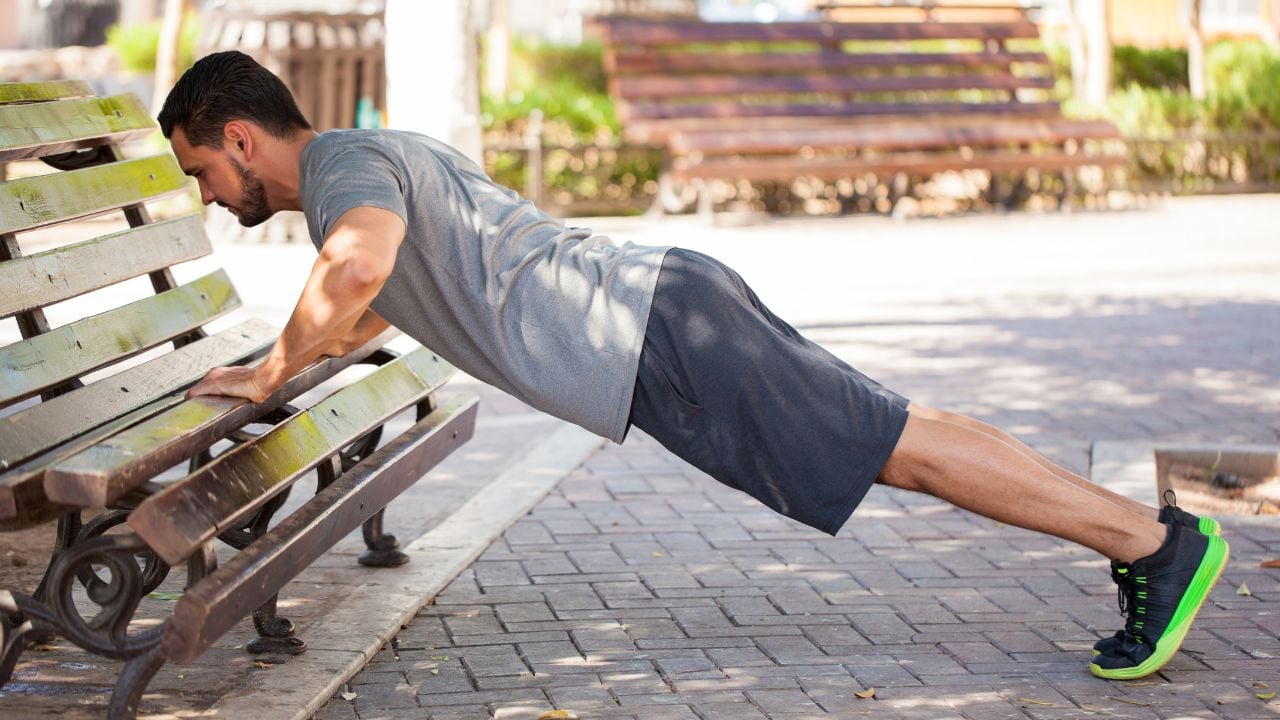
- A Beginner’s Guide on How to Do Push-Ups
- Start with Beginner-Friendly Modifications
- Master the Basics
- Gradually Increase the Difficulty
- Muscle Worked During Beginner-Friendly Knee Push Ups
- The 10 Best Push-Ups for Beginners
- 1. Wall Push Up
- 2. Incline Push-Up
- 3. Knee Push Up
- 4. Knee Diamond Push-Up
- 5. Incline Push Up On Stepper
- 6. Knee Cobra Push Up
- 7. Elbows-Back Push-Ups (Chaturanga)
- 8. Plank Push Up
- 9. Standard Push-Ups
- 10. Wide Grip Push Up
- Push-Up Routine for Beginners
- Push-Up Progression For Beginners
- 1. Start Slowly
- 2. Focus On Proper Form
- 3. Increase The Intensity
- 4. Vary Your Workouts
- FAQs
- Are beginner push-ups effective?
- How many pushups should a beginner do?
- Push-up challenge for beginners.
- Is it OK to do push-ups every day?
A Beginner’s Guide on How to Do Push-Ups
Here are a few tips to help you get started with push-ups as a beginner:
Start with Beginner-Friendly Modifications
If you’re a beginner, you can modify the push-up, which reduces the weight you need to lift and allows you to focus on proper form.
Don’t worry if a standard push-up is too tough right now. Here are a few easy variations to get you started:
- Wall Push-Ups: Stand an arm’s length from a wall and lean forward.
- Incline Push-Ups: Use a sturdy chair, bench, or even stairs. The higher the surface, the easier it will be.
- Knee Push-Ups: Start in a standard push-up position, but drop your knees to the ground.
Start with knee push-ups and incline push-ups, and you can also reduce the intensity by decreasing the angle of your body against the box and wall.
When you can do 15-20 wall push-ups in a row, or you may want to increase the intensity of push-ups, then try doing the incline and knee push ups
Master the Basics
Quality is more important than quantity when it comes to push-ups.
It’s important to focus on correct form when doing push-ups to avoid injury and get the most out of the exercise.
- Keep your body straight: Make sure to keep your body straight as you lower down and push back up.
- Engage That Core: Tighten your abs to protect your lower back and create a stable base for the movement.
- Elbows In: Keep your elbows tucked close to your body instead of flaring out to the sides.
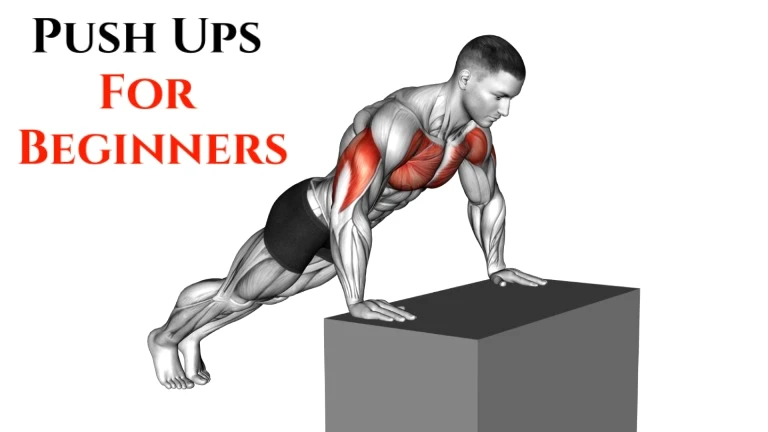
Gradually Increase the Difficulty
It is important to start with a small number of push-ups and gradually increase as you become stronger. This will increase the difficulty and continue to challenge your muscles.
Once you can comfortably do 15-20 reps of your chosen beginner variation, it’s time to progress! Increase the challenge by:
- Lowering the Incline: If you started with wall push-ups, move to a lower incline.
- From Knees to Toes: Carefully try a few standard push-ups. If you can’t keep good form, return to knee push-ups for a while longer.
Muscle Worked During Beginner-Friendly Knee Push Ups
Push-ups primarily work the chest muscles (pectoralis major and minor), as well as the triceps and the front of the shoulders (anterior deltoids).
They also engage the core muscles, back muscles, serratus anterior as they help to stabilize the body during the exercise.
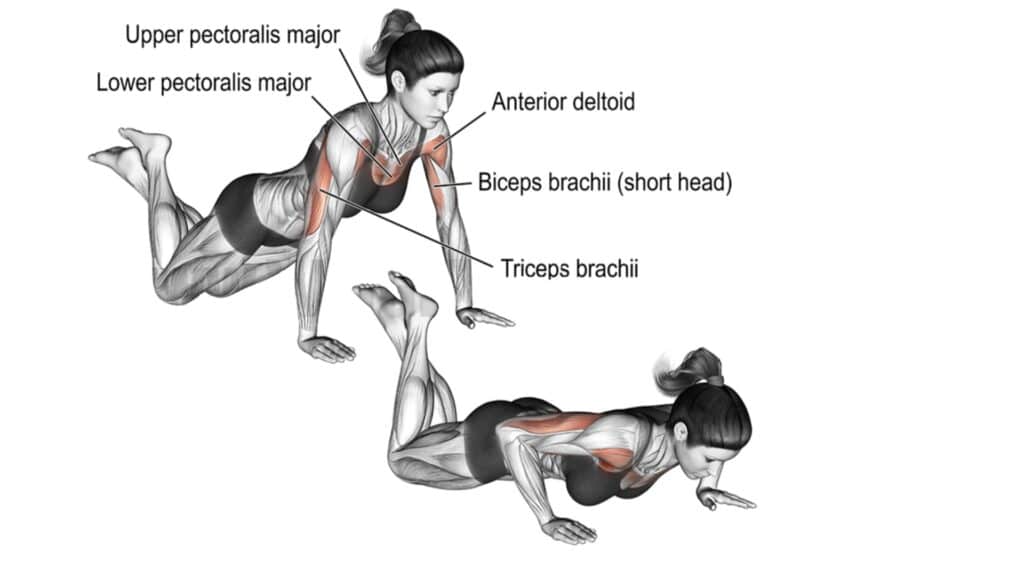
Here’s how these muscles are engaged during the knee push-up:
- Chest muscles: The chest muscles are responsible for moving the arms and shoulders, and they’re activated as you push your body away from the wall or floor.
- Triceps: The triceps are the muscles on the back of the upper arm, and they’re responsible for extending the elbow. They’re engaged as you straighten your arms during the push-up.
- Shoulders: They are responsible for flexing the arm and engaged as you lift your body off the wall.
The 10 Best Push-Ups for Beginners
Build strength, increase your endurance, and improve your lung capacity with these 10 dynamic push-up workouts for beginners.
With a few simple adjustments to your routine, you can master the perfect push-up in no time.
1. Wall Push Up
A wall push-up is a modified push-up exercise performed against a wall instead of the floor. Wall push-ups are gentler on the wrists and lower back than standard push-ups.
They are a great way for beginners to build their core strength and upper body strength. It dramatically reduces the pressure on the arms, upper back, and abs.
It is easier to perform this push-up if you stand closer to the wall, but remember, being aware of your body alignment is still important.
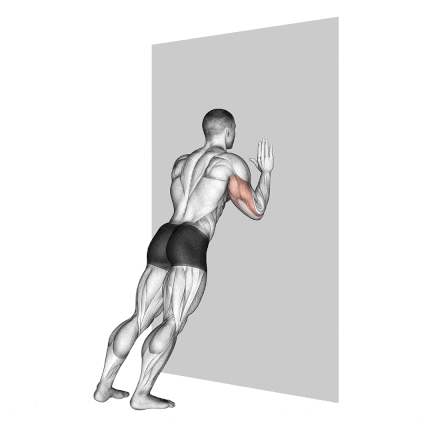
How To Do
- Stand facing a wall, about an arm’s length away.
- Place your feet shoulder-width apart for stability.
- Place your hands on the wall at shoulder height, slightly wider than shoulder width apart.
- Slowly bend your elbows and lean towards the wall until your chest nearly touches it.
- Push back against the wall until you are in a straight-arm position, then repeat.
Tips
- The movement should be smooth and controlled.
- Try not to flare your elbows to the sides.
2. Incline Push-Up
The incline position reduces the amount of bodyweight you have to lift and puts less stress on your elbows. It’s perfect for beginners and pros who want to strengthen their upper body.
Incline push-ups slightly shift the focus to your lower chest muscles compared to a standard push-up.
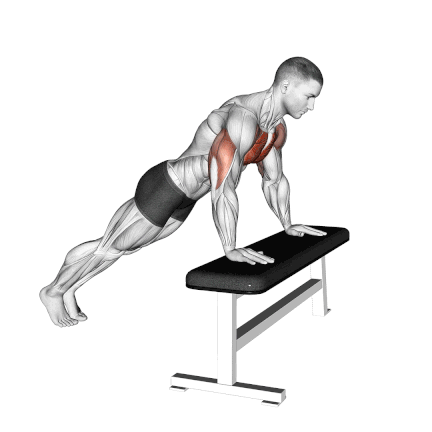
How To Do
- Choose a sturdy bench, chair, box, or stairs.
- The higher the surface, the easier the push-up will be.
- Place your hands slightly wider than shoulder-width apart on the elevated surface.
- Walk your feet back until your body forms a straight line from your head to your heels.
- Slowly bend your elbows, lowering your chest towards the elevated surface.
- Push yourself back to the starting position.
Tips
- Be sure the bench or chair is stable and secure before you perform the push-ups.
- Your back and legs should be straight at all times.
- Keep your elbows slightly tucked towards your body.
3. Knee Push Up
The knee push-up is a modified version of the standard push-up. Instead of being on your toes, you rest your knees on the ground. This helps you lift less weight.
They are a good way to start if you have trouble doing the standard push-ups.
It is a great way to strengthen your chest muscles and train your shoulders and triceps.
A study has shown that a bent-knee push-up test may be a more suitable strength assessment for college-age women.
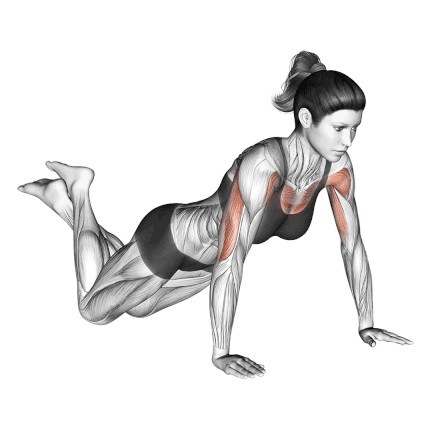
How To Do
- Begin in a standard push-up position.
- Carefully lower your knees to the ground while maintaining the plank position.
- Slowly bend your elbows and lower your chest toward the floor.
- When you reach the near ground, push back up to the starting position to complete one repetition, and then begin again.
Tips
- If your knees are sensitive, place a folded towel or mat under them for cushioning.
- Keep your core tight and your body straight from your shoulders to your knees.
- Keep your back straight — never rounded! — throughout the move.
4. Knee Diamond Push-Up
The knee diamond push-up is a variation of the standard knee push-up with a narrower hand placement.
Your hands form a diamond shape (thumbs and index fingers touching) directly under your chest.
This hand position increases activation of the triceps compared to a wider push-up stance.
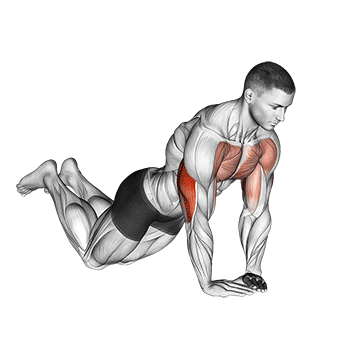
How To Do Knee Diamond Push-Ups
- Get into a knee push-up position.
- Bring your hands together under your chest, with your index fingers and thumbs touching to form a diamond shape.
- Lower your body down towards the ground until your chest touches the ground.
- Then push back up to the starting position.
Tips
- Keep your body straight and rigid and your elbows close to your body
- The movement should be smooth and controlled.
5. Incline Push Up On Stepper
The incline push-up on a stepper is a push-up variation where you elevate your hands on an aerobic step.
This reduces the amount of body weight you lift compared to a standard push-up but slightly increases the difficulty compared to a regular incline push-up.
It is an excellent progression step if you’re working towards full push-ups.
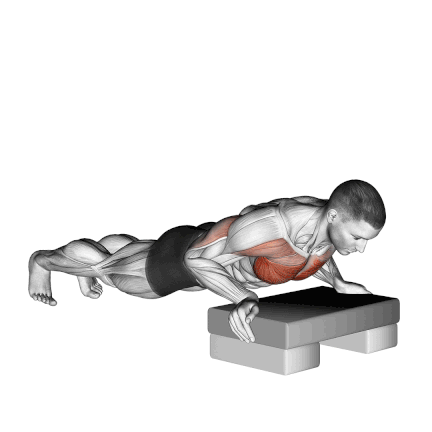
How To Do
- Place a sturdy aerobic step in front of you. Adjust the height (higher means easier).
- Your hands should be slightly wider than shoulder-width apart.
- Slowly bend the arms to lower the chest toward the stepper.
- Push the body away from the stepper by extending the arms and keeping the elbow bent.
Tips
- Keep your elbows slightly tucked in towards your body.
- Make sure to keep your body straight and your core engaged.
- If it’s too difficult, increase the step height.
6. Knee Cobra Push Up
The Knee Cobra Push Up is a variation of the standard push-up designed for intermediate athletes who are looking to increase difficulty and core control.
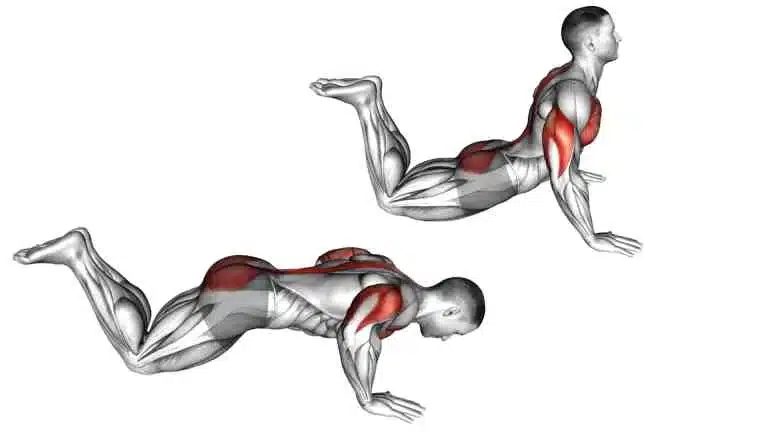
How To Do
- Begin in a knee plank position with your knee on the ground and hands placed shoulder width apart.
- As you lower down, press into your knee as you lift your hips off the ground—this motion should resemble a standard cobra pose in yoga.
- Keep your core engaged, and don’t push forward too much.
- When reaching the halfway point, press back up through your arms until you are back in the starting position to complete one repetition.
7. Elbows-Back Push-Ups (Chaturanga)
Slightly more advanced than the others, chaturanga dandasana (or “Four-limbed Staff Pose”). It is an isometric exercise that will test your grip strength and stamina and give you great results in terms of toning your arms.
Chaturanga is a powerhouse for strengthening your core, shoulders, triceps, and chest.
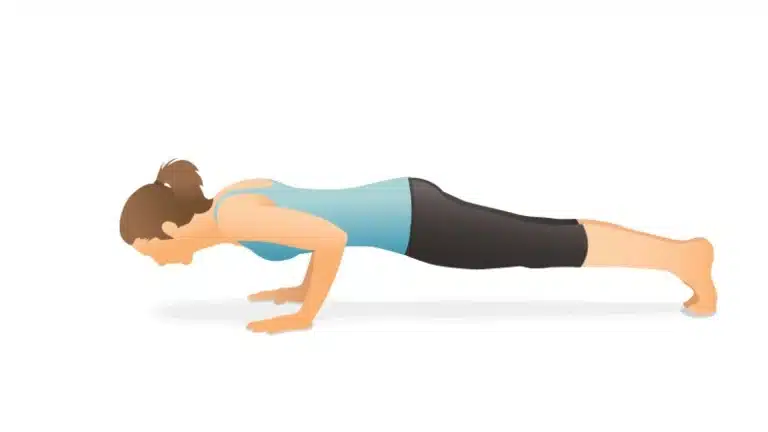
How To Do
- Begin in a high plank position: hands under shoulders.
- Slowly bend your elbows, hugging them close to your sides, lowering your body parallel to the floor.
- Maintain the hover position, keeping your shoulders above your elbows and your body in a rigid plank.
Tips
- If this is too challenging, lower your knees to the ground for a modified Chaturanga.
- Avoid letting your hips sag or pike.
- Take your time, and prioritize form.
8. Plank Push Up
A Plank to Push-up is a full-body exercise. The move takes a standard plank to the next level by adding an element of control, moving arm work.
Maintaining a plank position, you alternate between a forearm plank and a high plank.
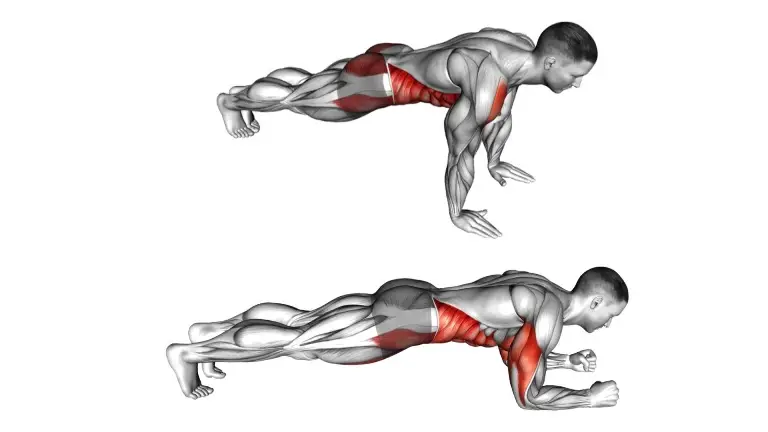
How To Do
- Lie face down on an exercise mat with hands shoulder-width apart.
- Start to get in a push up position, bend your elbows and rest your weight on your forearms instead of on your hands.
- Brace your core by contracting your abs like you were about to be punched in the gut.
- Press your body up into the top position of a push-up by extending your arms one at a time.
- Pause, then reverse the movement and return to your elbows. That’s 1 rep
9. Standard Push-Ups
While many push-up variations target specific muscles, the standard push-up provides the most balanced workout for your chest, shoulders, triceps, and core.
Mastering the standard push-up form and strength is essential before attempting more advanced variations like decline push-ups, one-armed push-ups, or plyometric push-ups.
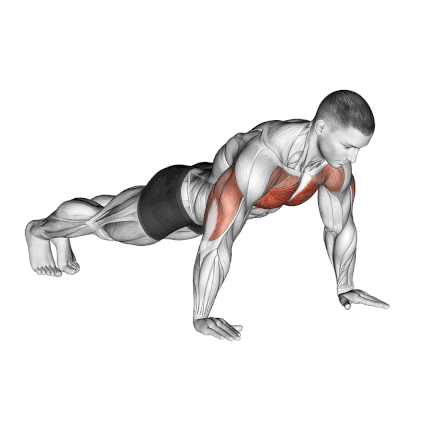
How To Do
- Begin in a high plank position.
- Place hands slightly wider than shoulder-width apart, directly under your shoulders.
- Inhale and bend your elbows to lower your body down until your chest is just above the floor.
- Exhale and push through your palms to straighten your arms and return to the starting position.
Tips
- Engage your core muscles and maintain a straight, rigid torso.
- Keep your body in a straight line – don’t let your hips sag or back arch.
- Control the movement both as you lower down and push back up.
10. Wide Grip Push Up
If you’ve mastered regular pushups and want to try challenging push-up variations, wide pushups are a good option for you.
Wide grip push up provides all the benefits of a normal push-up, with a special focus on the shoulder and outer chest.
For some people, a wider grip can feel less stressful on the shoulder joints compared to close-grip push-ups.
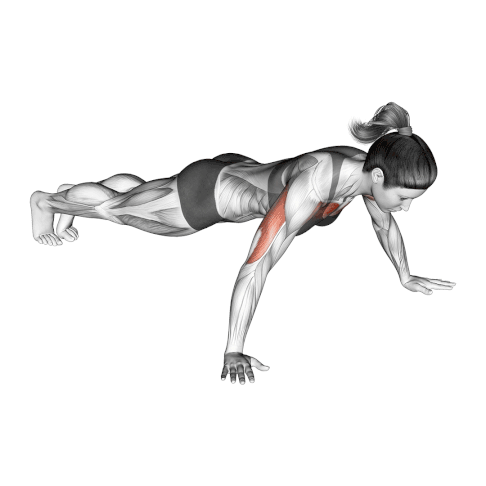
How To Do
- Get into a standard push-up position with hands wider than shoulder-width apart.
- Your feet should be hip-width apart, and your body should form a straight line from your head to your heels.
- Lower your body towards the floor.
- As you lower your body, keep your core tight and your body straight.
- When your chest is just above the floor, push through your hands to straighten your arms and return to the starting position.
- Do 8-12 reps and 3-4 sets.
Tips
- Keep your elbows close to your body and ensure not to let your hips sag or your back arch.
- Perform 2–3 sets of 6–8 repetitions. Add more reps and sets as you build strength.
Push-Up Routine for Beginners
Here is a simple push-up program for beginners:
- Start with 3 sets of 5–10 reps of modified push-ups on your knees or against a wall. Rest for 30–60 seconds between sets.
- Gradually increase the number of reps and sets as you get stronger. Aim for 3–4 sets of 8–12 reps with good form.
- Once you can comfortably complete 3–4 sets of 8–12 reps of modified push-ups, you can progress to full push-ups.
- As you get stronger, you can also try adding variations such as wide-grip push-ups or diamond push-ups to challenge your muscles in different ways.
Remember to listen to your body and never push yourself beyond your limits.
It’s important to progress slowly and safely to avoid injury.
Push-Up Progression For Beginners
Here are a few tips to help you build up the progression of your beginner push-ups:
1. Start Slowly
If you’re new to push-ups or are returning to exercise after a break, it’s important to start slowly and gradually increase the difficulty of the exercise as you get stronger.
You can start with a small number of reps and gradually increase the number of reps and sets as you get more comfortable.
2. Focus On Proper Form
Good form is essential for getting the most out of your push-ups.
Be sure to keep your body straight and your core engaged. Keep your elbows close to your body as you lower and raise yourself.
3. Increase The Intensity
As you grow stronger, you can increase the intensity of your push-up.
You can improve your workout routine by doing more sets and reps and adding standard, incline and decline push-ups.
4. Vary Your Workouts
To keep your workouts interesting and challenging, be sure to mix up your exercises and include a variety of exercises that target different muscle groups.
This will help ensure you get a well-rounded workout and avoid overuse injuries.
Overall, the key to building up the progression of beginner push-ups is to start slowly, focus on proper form, and gradually increase the intensity and difficulty of the exercise as you get stronger.
FAQs
Are beginner push-ups effective?
Yes, beginner push-ups can effectively build upper body strength and muscle endurance.
Knee and incline push-ups are a good starting point because they let you focus on proper form and build strength and stability.
As you get stronger, you can gradually progress to full push-ups and increase the number of reps and sets
How many pushups should a beginner do?
For push-ups, you can start with 3 sets of 5–10 reps and increase the number of reps as you get stronger.
As a general guideline, aim to complete 3–4 sets of 8–12 reps with good form.
If you find it hard to do this many reps, you can start with knee push-ups and move up to full push-ups as you get stronger.
Push-up challenge for beginners.
A push-up challenge for beginners could involve starting with a certain number of reps and gradually increasing the number of reps each day or week.
For example:
- You could start with 5 push-ups on day 1 and add one push-up each day until you reach a certain goal, such as 30 push-ups in a row.
- Alternatively, you could aim to increase the number of weekly sets or reps.
- Or increase the difficulty of the push-ups by using a steeper incline or adding variations such as wide-grip push-ups or diamond push-ups.
Remember to warm up before starting any exercise routine and cool down afterward.
Is it OK to do push-ups every day?
It’s generally okay to do push-ups daily as part of a well-rounded exercise routine, provided you are using good form and not pushing yourself beyond your limits.
However, listening to your body and giving yourself adequate rest between workouts is important.
It’s important to vary your workouts to avoid overuse injuries and allow your muscles time to recover and repair.
You can incorporate other upper body exercises such as dumbbell rows, tricep dips, and bench press into your routine to provide balance and variety.
References
- Ebben WP, Wurm B, VanderZanden TL, Spadavecchia ML, Durocher JJ, Bickham CT, Petushek EJ. Kinetic analysis of several variations of push-ups. J Strength Cond Res. 2011 Oct;25(10):2891-4. doi: 10.1519/JSC.0b013e31820c8587. PMID: 21873902.
- Heather M. Wood & Ted A. Baumgartner (2004) Objectivity, Reliability, and Validity of the Bent-Knee Push-Up for College-Age Women, Measurement in Physical Education and Exercise Science, 8:4, 203-212.

Manish is a NASM-certified fitness and nutrition coach with over 10 years of experience in weight lifting and fat loss fitness coaching. He specializes in gym-based training and has a lot of knowledge about exercise, lifting technique, biomechanics, and more.
Through “Fit Life Regime,” he generously shares the insights he’s gained over a decade in the field. His goal is to equip others with the knowledge to start their own fitness journey.
